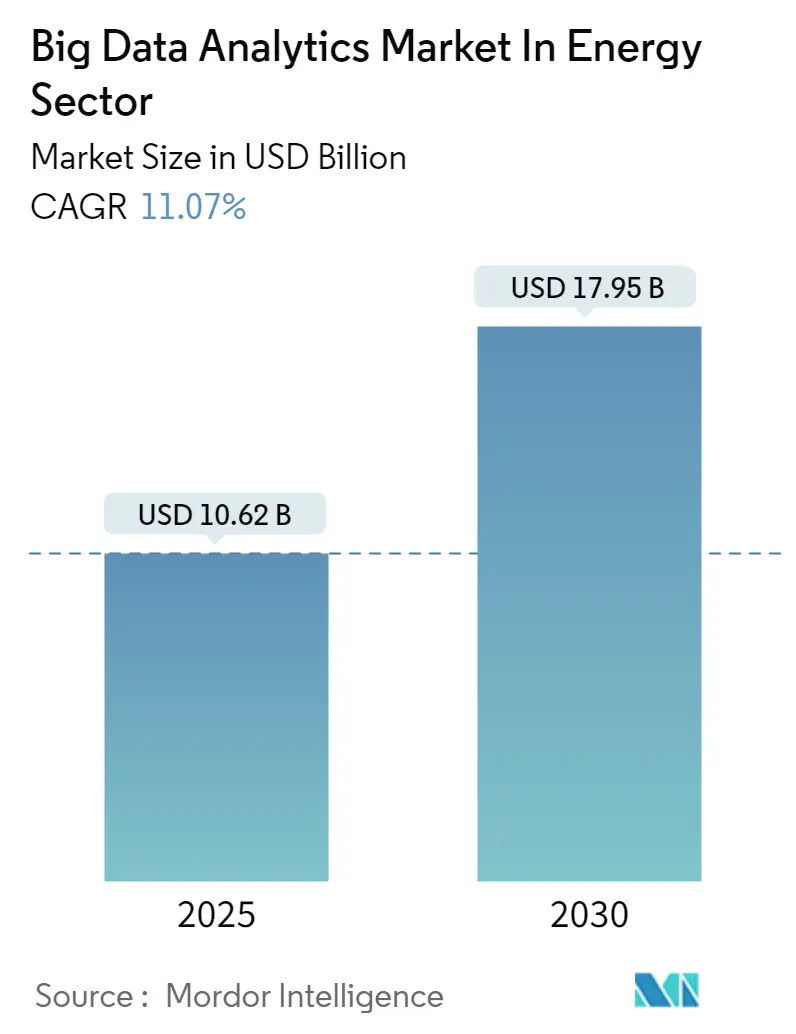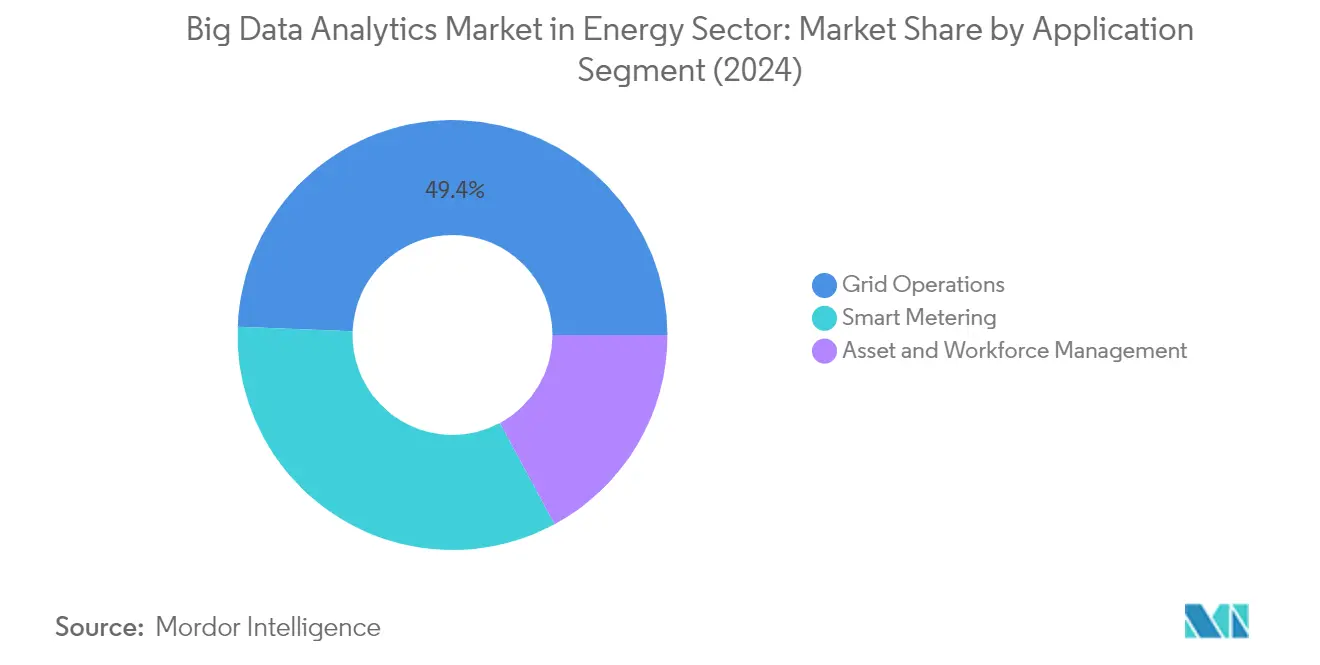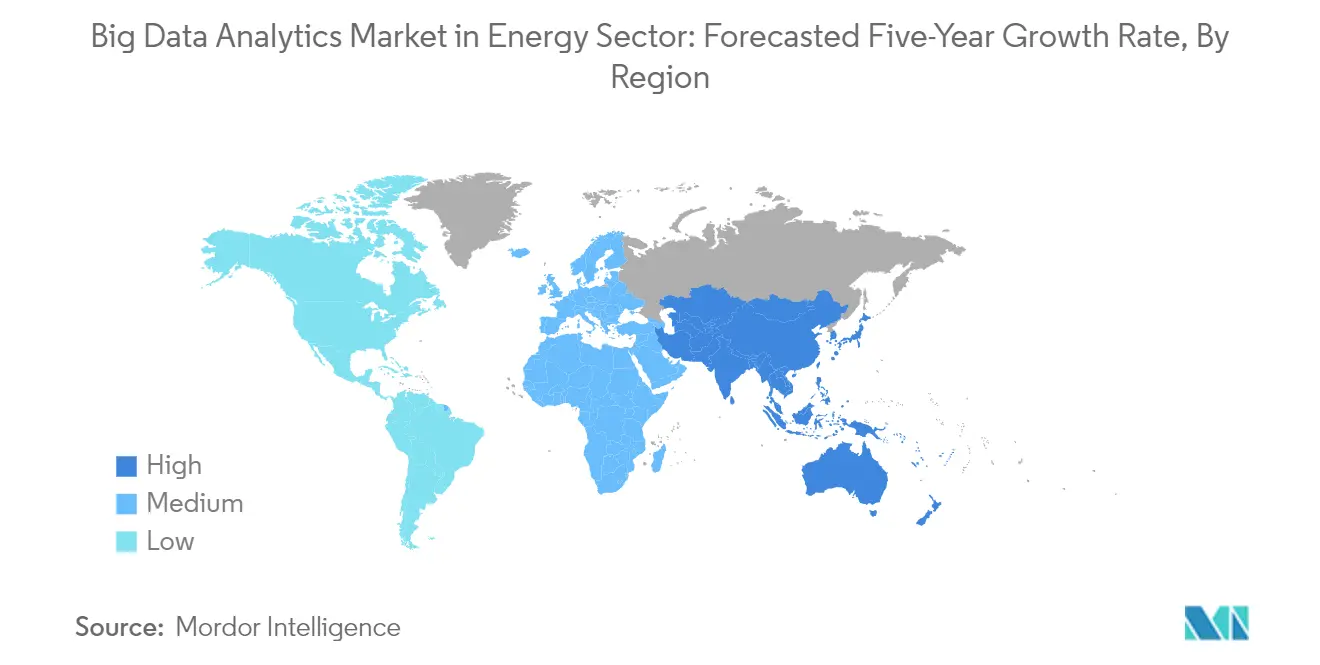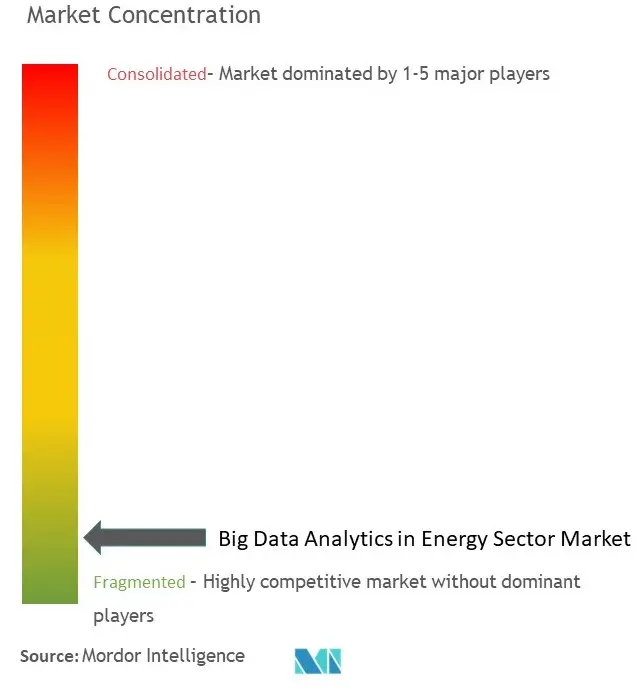
| Study Period | 2019 - 2030 |
| Market Size (2025) | USD 10.62 Billion |
| Market Size (2030) | USD 17.95 Billion |
| CAGR (2025 - 2030) | 11.07 % |
| Fastest Growing Market | Asia Pacific |
| Largest Market | North America |
| Market Concentration | Low |
Major Players
*Disclaimer: Major Players sorted in no particular order |
Big Data Analytics in Energy Sector Market Analysis
The Big Data Analytics Market In Energy is expected to grow from USD 10.62 billion in 2025 to USD 17.95 billion by 2030, at a CAGR of 11.07% during the forecast period (2025-2030).
The energy sector is undergoing a profound transformation driven by increasing global energy demands and the transition toward sustainable resources. According to recent projections, worldwide energy data analytics is expected to play a crucial role as energy consumption is forecasted to reach 886.3 quadrillion British thermal units by 2050, highlighting the critical need for sophisticated data analytics in the energy sector solutions in managing this growing demand. This transformation is particularly evident in the power generation sector, where utilities are increasingly adopting digital solutions to optimize operations and improve grid reliability. The integration of advanced analytics capabilities has become essential for utilities to manage complex grid operations, forecast demand patterns, and ensure efficient resource allocation across their networks.
The adoption of smart metering infrastructure has emerged as a cornerstone of modern energy management systems. In Great Britain alone, 33.9 million smart and advanced meters were installed in residences and small companies by the end of September 2023, representing 59% of total meters. This widespread deployment of smart meters is generating unprecedented volumes of granular data, enabling utilities to gain deeper insights into consumption patterns and grid performance. The transformation extends beyond mere data collection, as utilities are increasingly implementing sophisticated analytics platforms to convert this data into actionable intelligence for improved operational efficiency and customer service. The application of big data in this context is revolutionizing how utilities approach energy management.
The renewable energy sector has become a significant driver of analytics adoption, with utilities seeking to optimize the integration of variable power sources into existing grid infrastructure. Germany's achievement of 51.6% renewable energy in gross electricity consumption in 2023 exemplifies the growing importance of advanced analytics in managing renewable energy integration. This shift towards renewable sources has created new challenges in grid management, requiring more sophisticated predictive analytics capabilities to forecast generation patterns and maintain grid stability. Energy companies are increasingly investing in big data analytics in energy and utilities solutions that can handle the complexity of renewable energy integration while ensuring reliable power distribution.
The United States has demonstrated significant progress in modernizing its energy infrastructure, with 128 million smart meter deployments completed by the end of 2023. This extensive smart meter network has created a foundation for advanced analytics applications, enabling utilities to implement more sophisticated demand response programs and improve grid reliability. Enterprise-level analytics platforms are becoming increasingly prevalent, offering comprehensive solutions that combine real-time monitoring, predictive maintenance, and customer engagement capabilities. These platforms are helping utilities optimize their operations while providing valuable insights for future infrastructure investments and service improvements. The role of big data in the energy sector is crucial in these advancements, supporting the evolution of energy systems and data analytics.
Big Data Analytics in Energy Sector Market Trends
Enormous Influx of Data
The energy sector is experiencing an unprecedented surge in data generation driven by the widespread adoption of smart meters, IoT sensors, and grid modernization initiatives. Traditional electricity meters previously generated minimal data that could be manually collected and analyzed primarily for billing purposes. However, modern smart meters can now send consumer energy usage data every 15 minutes, resulting in approximately 96 million reads per day for every million meters—a 3,000-fold increase compared to conventional monthly readings. This massive influx of data is further exemplified by recent deployments, with 128 million smart meters installed in the United States by the end of 2023, and 33.9 million smart meters deployed in Great Britain by September 2023, accounting for 59% of total meters.
The data explosion extends beyond smart meters to encompass various operational aspects of the energy sector. Grid operations now generate extensive data through two-way communication systems, sensor networks, and advanced metering infrastructure (AMI). This includes real-time information about grid connectivity, power quality, equipment health, and consumer behavior patterns. For instance, companies like GE have introduced new analytics technologies that enable utilities to process data from transmission and distribution networks for enhanced operational efficiency. Similarly, platforms like Bazefield demonstrate the industry's evolution, offering comprehensive monitoring and analytics capabilities for multiple energy sources including wind power, solar, hydro, biomass, and battery storage, while incorporating machine learning-based analytics to process and analyze this vast amount of data effectively. Energy big data is a critical component in this transformation, enabling more informed decision-making and operational improvements.
Volatility in Oil Prices
The persistent volatility in oil prices has emerged as a crucial driver for energy big data analytics adoption in the energy sector, compelling companies to implement sophisticated data-driven solutions for cost optimization and risk management. Energy companies are leveraging energy data analysis to streamline operational costs and develop more accurate predictive models for market fluctuations. For example, major players in the industry are utilizing advanced analytics to anticipate equipment wear, optimize rig utilization, and improve recovery factors, enabling them to maintain profitability despite price uncertainties. This is particularly evident in how companies like Chevron have implemented IoT-based predictive maintenance solutions that collect real-time sensor data to measure critical parameters such as pH levels, aqueous CO2/H2S content, and gaseous leakages, helping mitigate costly infrastructure issues before they occur.
The impact of price volatility has also accelerated the industry's transition toward more data-intensive decision-making processes. Energy companies are increasingly utilizing energy predictive analytics to manage risks, optimize resource allocation, and identify new revenue opportunities. For instance, researchers have developed sophisticated models that combine natural language processing with historical data to better assess crude oil price risks and improve forecasting accuracy. These advanced analytical capabilities are particularly crucial as the industry faces growing pressure to balance traditional energy sources with renewable alternatives. According to the International Energy Agency, global energy needs are projected to expand by 55% between 2005 and 2030, rising from 11.4 billion to 17.7 billion metric tons of oil equivalent, making efficient resource management through data analytics increasingly vital for maintaining operational stability amid price fluctuations. This underscores the importance of energy market intelligence in navigating the complexities of the modern energy landscape.
Segment Analysis: By Application
Grid Operations Segment in Big Data Analytics Market in Energy Sector
Grid Operations continues to dominate the big data analytics for utilities market in the energy sector, commanding approximately 49% of the total market share in 2024. This segment's prominence is driven by the increasing complexity of power grid operations and the need for real-time data analytics in the utility industry to manage distributed energy resources effectively. The integration of renewable energy sources into existing grid infrastructure has created a pressing need for advanced analytics solutions that can handle two-directional power flows and complex control strategies. Traditional electromechanical electric grids are being enhanced with digital information and telecommunications networks to overcome power outages and quality disturbances that cost billions of dollars annually. Grid operations analytics enable utilities to implement sophisticated monitoring systems, optimize power distribution, and ensure grid stability through real-time data analysis and predictive modeling.

Asset and Workforce Management Segment in Big Data Analytics Market in Energy Sector
The Asset and Workforce Management segment is emerging as the fastest-growing segment in the big data analytics for utilities market for the energy sector, with a projected growth rate of approximately 12% during the forecast period 2024-2029. This rapid growth is attributed to the increasing complexity of managing diverse asset classes in smart grids, including hardware, firmware, software, communications systems, and storage capabilities. The segment's growth is further fueled by the need for predictive maintenance analytics, which helps utilities improve total uptime, reduce asset maintenance costs, and enhance overall asset health. The integration of IoT connectivity and advanced analytics enables better workforce management by providing drill-down capabilities to understand productivity patterns and optimize resource allocation across various operational areas.
Remaining Segments in Big Data Analytics Market in Energy Sector
The Smart Metering segment represents a crucial component of the data analytics in the utility industry market in the energy sector, focusing on essential functions such as grid operations, field services, resource planning, customer experience, and regulatory compliance. This segment plays a vital role in enhancing demand forecasting through data generation and analysis, which helps in efficient energy management and consumption optimization. Smart metering analytics enable utilities to process vast amounts of energy data insights from multiple sources, including consumption patterns, fault information, outage details, and pricing data, providing valuable insights for operational decision-making and customer service improvement.
Big Data Analytics Market In Energy Sector Geography Segment Analysis
Big Data Analytics Market in Energy Sector in North America
North America stands as a dominant force in the energy market data analytics market for the energy sector, commanding approximately 40% of the global market share in 2024. The region's leadership position is primarily driven by its strong foundation in technological innovation and early adoption of advanced analytics solutions. The United States plays a pivotal role in driving regional growth, particularly through increased demand from oil and gas, refining, and power generation segments. The region's utilities sector has shown remarkable progress in implementing smart grid technologies, with many large investor-owned utilities either fully deploying big data analytics or being in the implementation phase. The presence of major energy data analytics companies and a robust infrastructure for data analytics implementation further strengthens North America's position. The region's focus on renewable energy integration, coupled with the growing emphasis on predictive maintenance solutions in the oil and gas sector, continues to drive market expansion. Additionally, the strong regulatory framework and increasing investments in grid modernization initiatives have created a favorable environment for the adoption of big data analytics solutions.

Big Data Analytics Market in Energy Sector in Europe
Europe has demonstrated substantial growth in the energy market data analytics market for the energy sector, with an estimated growth rate of around 10% during 2019-2024. The region's market dynamics are shaped by its position as one of the most advanced crude oil refiners globally and its aggressive push toward digital transformation in the energy sector. The European market is characterized by a strong emphasis on renewable energy integration and smart grid deployment, particularly in countries like Germany and the United Kingdom. The region's utilities are increasingly focusing on data-driven decision-making processes to optimize energy distribution and consumption patterns. The presence of stringent regulatory frameworks regarding energy efficiency and carbon emissions has accelerated the adoption of analytics solutions. European energy companies are particularly focused on leveraging big data analytics for grid modernization, renewable energy integration, and improving operational efficiency. The region's commitment to sustainability goals and the increasing need for efficient energy management systems continue to drive market growth.
Big Data Analytics Market in Energy Sector in Asia-Pacific
Asia-Pacific emerges as the fastest-growing region in the energy market data analytics market for the energy sector, with a projected CAGR of approximately 13% during 2024-2029. The region's market is characterized by rapid industrialization, increasing energy demand, and substantial investments in smart grid infrastructure. Countries like China, India, and Japan are at the forefront of this growth, driven by their ambitious smart city initiatives and digital transformation programs. The region's utilities are increasingly adopting advanced metering infrastructure and smart grid technologies to improve operational efficiency and reduce power losses. The growing focus on renewable energy data analytics, particularly in countries like Japan and Singapore, has created new opportunities for big data analytics applications. The presence of a large manufacturing base and increasing urbanization continues to drive energy demand, necessitating more sophisticated analytics solutions. The region's commitment to grid modernization and the increasing adoption of IoT devices in the energy sector further accelerate market growth.
Big Data Analytics Market in Energy Sector in Latin America
Latin America represents an emerging market for big data analytics in the energy sector, with significant growth potential driven by increasing digitalization efforts and modernization of energy infrastructure. The region's utilities are gradually embracing smart meter technologies and advanced analytics solutions to improve operational efficiency and reduce energy losses. Countries like Brazil and Mexico are leading the regional adoption of smart grid technologies, with utilities implementing pilot projects and large-scale deployments. The region's focus on renewable energy integration, particularly in countries with substantial solar and wind resources, is creating new opportunities for analytics applications. The growing need for efficient grid management and the increasing awareness of the benefits of data-driven decision-making are driving market growth. Additionally, government initiatives supporting grid modernization and the increasing presence of international energy market data providers are helping accelerate market development in the region.
Big Data Analytics Market in Energy Sector in Middle East & Africa
The Middle East & Africa region presents unique opportunities in the big data analytics market for the energy sector, driven by ambitious digital transformation initiatives and increasing investments in smart city projects. The Kingdom of Saudi Arabia, United Arab Emirates, and Qatar are spearheading regional adoption, supported by their strong economic foundations and technological advancement initiatives. The region's focus on diversifying from traditional energy sources and implementing smart grid technologies is creating new opportunities for analytics applications. The increasing per capita electricity consumption and the need for efficient energy management systems are driving market growth. The region's utilities are gradually embracing digital solutions to improve operational efficiency and customer service. Additionally, the growing emphasis on renewable energy integration, particularly in countries with significant solar potential, is creating new demands for advanced analytics solutions to optimize energy generation and distribution.
Big Data Analytics in Energy Sector Industry Overview
Top Companies in Big Data Analytics in Energy Sector Market
The energy data analytics market in the energy sector is dominated by major technology companies, including IBM, Microsoft, SAP, Dell Technologies, Intel, Accenture, Infosys, and Palantir Technologies. These companies are driving innovation through continuous investment in research and development of advanced analytics capabilities, artificial intelligence, machine learning, and cloud computing solutions specifically tailored for the energy sector. The market leaders are focusing on developing comprehensive platforms that can handle massive volumes of data from smart meters, IoT sensors, and grid infrastructure while providing actionable insights for optimization and predictive maintenance. Strategic partnerships and collaborations with energy analytics companies have become increasingly common as vendors seek to enhance their domain expertise and deliver more specialized solutions. Companies are also expanding their geographical presence through acquisitions and establishing innovation centers to better serve regional markets and comply with local regulations.
Dynamic Market Structure Drives Industry Evolution
The competitive landscape is characterized by a mix of large multinational technology conglomerates and specialized analytics providers, each bringing unique strengths to the market. The major technology companies leverage their extensive resources, established client relationships, and comprehensive product portfolios to maintain their market positions, while specialized players focus on developing niche solutions for specific energy sector applications. The market shows moderate consolidation, with the top players holding significant market share through their ability to provide end-to-end solutions spanning data collection, storage, analysis, and visualization.
Merger and acquisition activity in the sector remains robust as companies seek to expand their capabilities and market reach. Large technology firms are actively acquiring innovative startups to incorporate new technologies and talent into their existing operations. Strategic partnerships between technology providers and energy companies are becoming increasingly common, creating integrated solutions that address specific industry challenges. Regional players are also emerging, particularly in developing markets, focusing on localized solutions that address specific market needs and regulatory requirements.
Innovation and Adaptability Drive Market Success
Success in the market increasingly depends on providers' ability to deliver scalable, secure, and customizable solutions that can adapt to evolving energy sector needs. Incumbent companies are focusing on strengthening their market position through continuous innovation in areas such as artificial intelligence, machine learning, and edge computing, while also expanding their industry-specific expertise through strategic partnerships and targeted acquisitions. The ability to provide comprehensive solutions that address both current and emerging challenges, such as renewable energy integration and grid modernization, while ensuring regulatory compliance and data security, has become crucial for maintaining market leadership.
For new entrants and smaller players, success lies in identifying and exploiting specific market niches where they can deliver unique value propositions. This includes developing specialized solutions for particular segments of the energy sector, such as commercial energy data analytics or grid optimization, and focusing on underserved regional markets. The concentration of end-users in the utility and energy sectors creates both opportunities and challenges, requiring providers to demonstrate clear value propositions and build strong relationships with key decision-makers. While substitution risk remains low due to the specialized nature of energy data analytics services, regulatory requirements around data privacy and security continue to shape market dynamics and influence product development strategies.
Big Data Analytics in Energy Sector Market Leaders
-
IBM Corporation
-
Siemens AG
-
SAP SE
-
Dell Technologies Inc.
-
Accenture PLC
- *Disclaimer: Major Players sorted in no particular order

Big Data Analytics in Energy Sector Market News
- January 2024 - Polaris Smart Metering announced that it signed two smart meter projects in Uttar Pradesh, India, worth a combined INR 5,200 crore (USD 623.4 million). The contracts for the installation of more than 5.1 million smart meters in the significant Lucknow and Ayodhya/Devipatan regions have been given to Madhyanchal Vidyut Vitran Nigam Limited (MVVNL). The business intends to install the meters over the course of the next 27 months.
- December 2023 - Xylem introduced its grid edge Stratus IQ+ smart electricity meter under the Sensus brand, which aims to give utilities more data than previously, including information on EV charging from customers. With its processor and additional options for data sets, utilities should be able to pull more system diagnostics than in the past, providing them with a greater understanding of consumer electricity usage and the health check of the distribution system.
Big Data Analytics in Energy Sector Market Report - Table of Contents
1. INTRODUCTION
- 1.1 Study Assumptions and Market Definition
- 1.2 Scope of the Study
2. RESEARCH METHODOLOGY
3. EXECUTIVE SUMMARY
4. MARKET INSIGHTS
- 4.1 Market Overview
-
4.2 Industry Attractiveness - Porter's Five Forces Analysis
- 4.2.1 Bargaining Power of Suppliers
- 4.2.2 Bargaining Power of Buyers/ Consumers
- 4.2.3 Threat of New Entrants
- 4.2.4 Threat of Substitutes
- 4.2.5 Intensity of Competitive Rivalry
- 4.3 An Assessment of the Impact of Macroeconomics Trends
5. MARKET DYNAMICS
-
5.1 Market Drivers
- 5.1.1 Enormous Influx of Data
- 5.1.2 Volatility in the Oil Prices
-
5.2 Market Restraints
- 5.2.1 Lack of Skilled Labor
6. MARKET SEGMENTATION
-
6.1 By Application
- 6.1.1 Grid Operations
- 6.1.2 Smart Metering
- 6.1.3 Asset and Workforce Management
-
6.2 By Geography
- 6.2.1 North America
- 6.2.2 Europe
- 6.2.3 Asia
- 6.2.4 Australia and New Zealand
- 6.2.5 Latin America
- 6.2.6 Middle East and Africa
7. COMPETITIVE LANDSCAPE
-
7.1 Company Profiles*
- 7.1.1 IBM Corporation
- 7.1.2 Siemens AG
- 7.1.3 SAP SE
- 7.1.4 Dell Technologies Inc.
- 7.1.5 Accenture PLC
- 7.1.6 Infosys Limited
- 7.1.7 Intel Corporation
- 7.1.8 Microsoft Corporation
- 7.1.9 Palantir Technologies Inc.
- 7.1.10 Enel X Italia Srl (Enel SpA)
8. INVESTMENT ANALYSIS
9. FUTURE OF THE MARKET
Big Data Analytics in Energy Sector Industry Segmentation
The market is defined by the revenue generated through the big data analytics solutions in the energy sector offered by various market players operating in the market. The study also tracks the key market parameters, underlying growth influencers, and major vendors operating in the industry, which support market estimations and growth rates over the forecast period.
Big data analytics in the energy sector market is segmented by application (grid operations, smart metering, asset, and workforce management) and by geography (North America, Europe, Asia, Latin America, and Middle East and Africa). The report offers market forecasts and size in value (USD) for all the above segments.
| By Application | Grid Operations |
| Smart Metering | |
| Asset and Workforce Management | |
| By Geography | North America |
| Europe | |
| Asia | |
| Australia and New Zealand | |
| Latin America | |
| Middle East and Africa |
Big Data Analytics in Energy Sector Market Research FAQs
How big is the Big Data Analytics Market In Energy?
The Big Data Analytics Market In Energy size is expected to reach USD 10.62 billion in 2025 and grow at a CAGR of 11.07% to reach USD 17.95 billion by 2030.
What is the current Big Data Analytics Market In Energy size?
In 2025, the Big Data Analytics Market In Energy size is expected to reach USD 10.62 billion.
Who are the key players in Big Data Analytics Market In Energy?
IBM Corporation, Siemens AG, SAP SE, Dell Technologies Inc. and Accenture PLC are the major companies operating in the Big Data Analytics Market In Energy.
Which is the fastest growing region in Big Data Analytics Market In Energy?
Asia Pacific is estimated to grow at the highest CAGR over the forecast period (2025-2030).
Which region has the biggest share in Big Data Analytics Market In Energy?
In 2025, the North America accounts for the largest market share in Big Data Analytics Market In Energy.
What years does this Big Data Analytics Market In Energy cover, and what was the market size in 2024?
In 2024, the Big Data Analytics Market In Energy size was estimated at USD 9.44 billion. The report covers the Big Data Analytics Market In Energy historical market size for years: 2019, 2020, 2021, 2022, 2023 and 2024. The report also forecasts the Big Data Analytics Market In Energy size for years: 2025, 2026, 2027, 2028, 2029 and 2030.
Our Best Selling Reports
Big Data Analytics Market In Energy Sector Research
Mordor Intelligence provides comprehensive insights into the rapidly evolving landscape of big data analytics in energy & utilities. Our expert industry analysis and consulting services offer a thorough examination of the application of big data across the energy sector. This includes energy data analytics and advanced analytical methodologies. The report delivers a detailed analysis of energy market data trends, covering developments in data analytics in energy sector and energy trading data analytics. With our expertise in business analytics in energy sector, we offer valuable insights into energy market intelligence and energy systems and data analytics.
Stakeholders benefit from our detailed examination of big data in energy sector industry dynamics. This is supported by profiles of energy data analytics companies and insights into energy market data analytics. The report, available in an easy-to-read PDF format for download, covers crucial aspects such as renewable energy data analytics, predictive analytics in energy sector, and data analytics in power sector. Our analysis includes energy data analysis methodologies, strategies of energy data providers, and implementations of energy trading data analytics software. This provides actionable intelligence for industry decision-makers. The report also explores applications of data analytics in utility industry and big data analytics for electric utilities, offering comprehensive coverage of this dynamic market segment.




